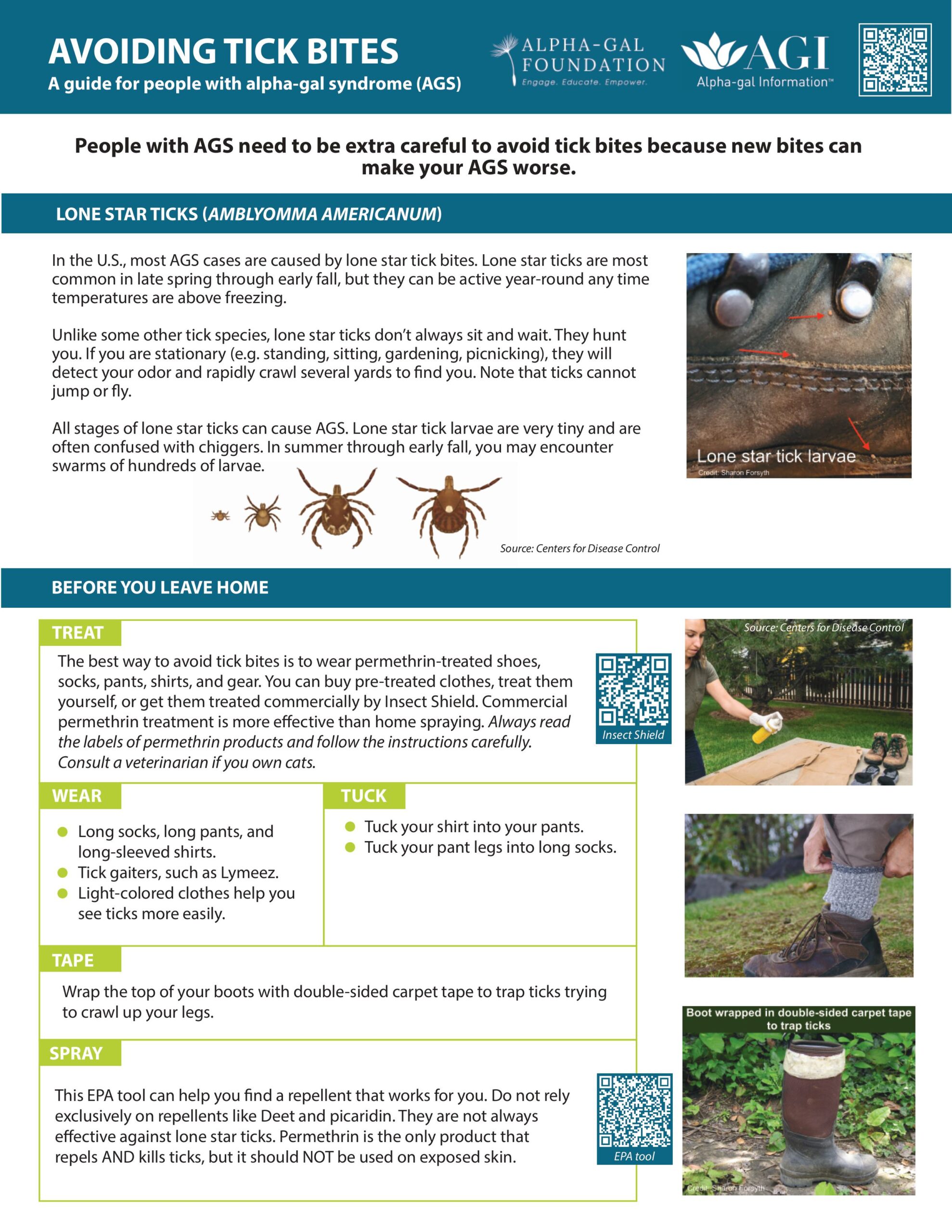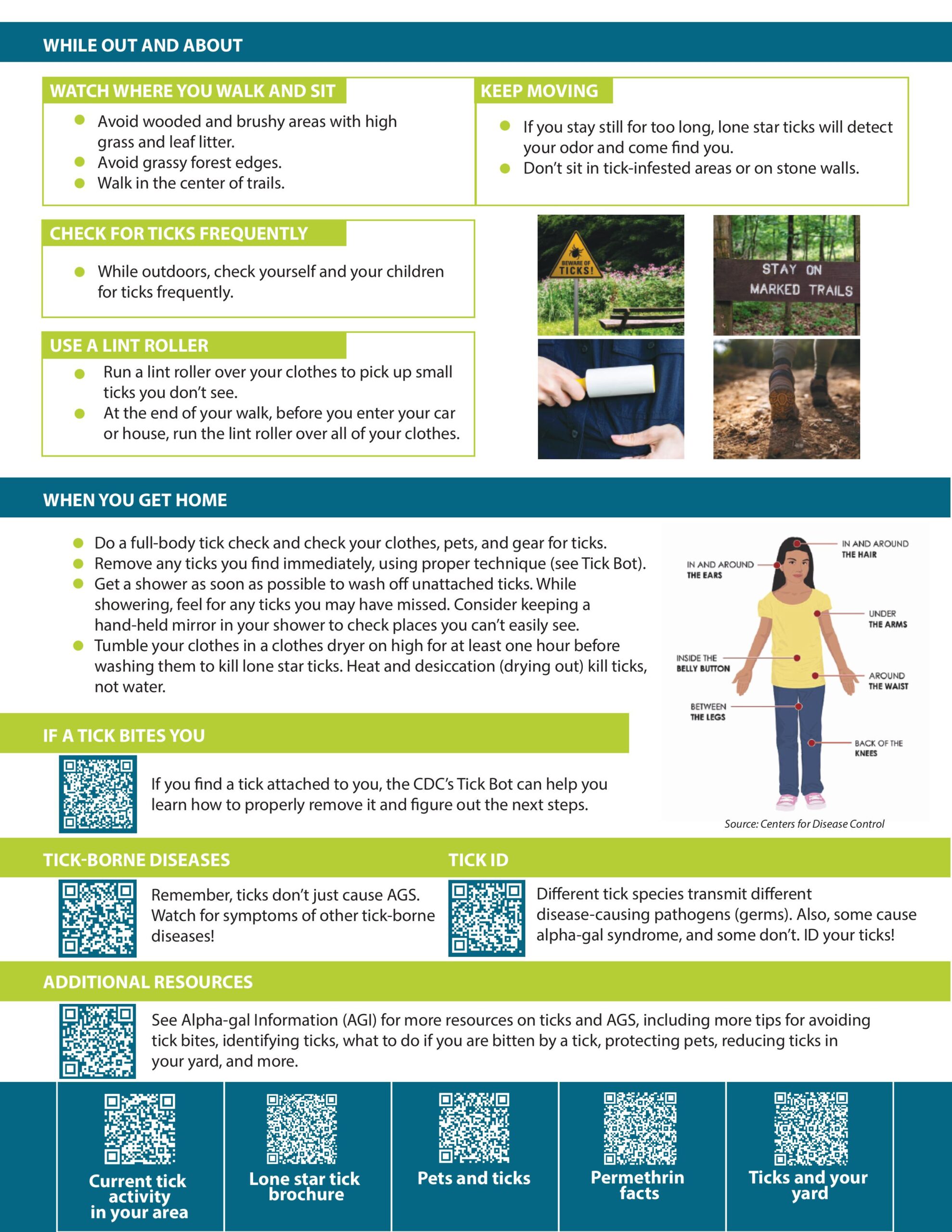Avoiding Tick Bites
A Guide for People with Alpha-gal Syndrome
If I already have alpha-gal syndrome, why do I need to avoid ticks?
If you have alpha-gal syndrome, it is important to avoid new tick bites. If you are bitten again, your alpha-gal IgE levels can increase and your symptoms may get worse (1,2). If you can avoid new tick bites your alpha-gal IgE will likely decline over time and with luck, your reactions to alpha-gal may become milder or you may stop reacting to alpha-gal altogether (2 3). Ticks also transmit infectious diseases.
For many years I had only a raw pain in my stomach and migraines after eating beef, but no other obvious symptoms. In 2017 I was bitten by a Lone Star Tick again and a week later my throat closed up and I had trouble breathing from the smell of cooking beef gravy. Not long after, one night I had just five Cheez-its. The next thing I know I had full blown anaphylaxis. That’s when I learned I was newly reactive to whey and dairy in general, in addition to the red meat. Everything changed after that bite. Even trace amounts affect me.
Next Level Tick Bite Avoidance Webinar
Strategies effective against lone star ticks
Know Your Enemy
Lone Star Ticks
If you live in the U.S., the tick most likely to give you alpha-gal syndrome is the Lone Star Tick. To avoid being bitten by a lone star tick, it will help if you KNOW YOUR ENEMY.
Lone star ticks differ from other ticks in important ways that impact which personal protection and tick control strategies do and do not work against them.
Learn about Lone Star Ticks here.
Before You Leave Home
When you can’t avoid tick-infested areas, take these precautions

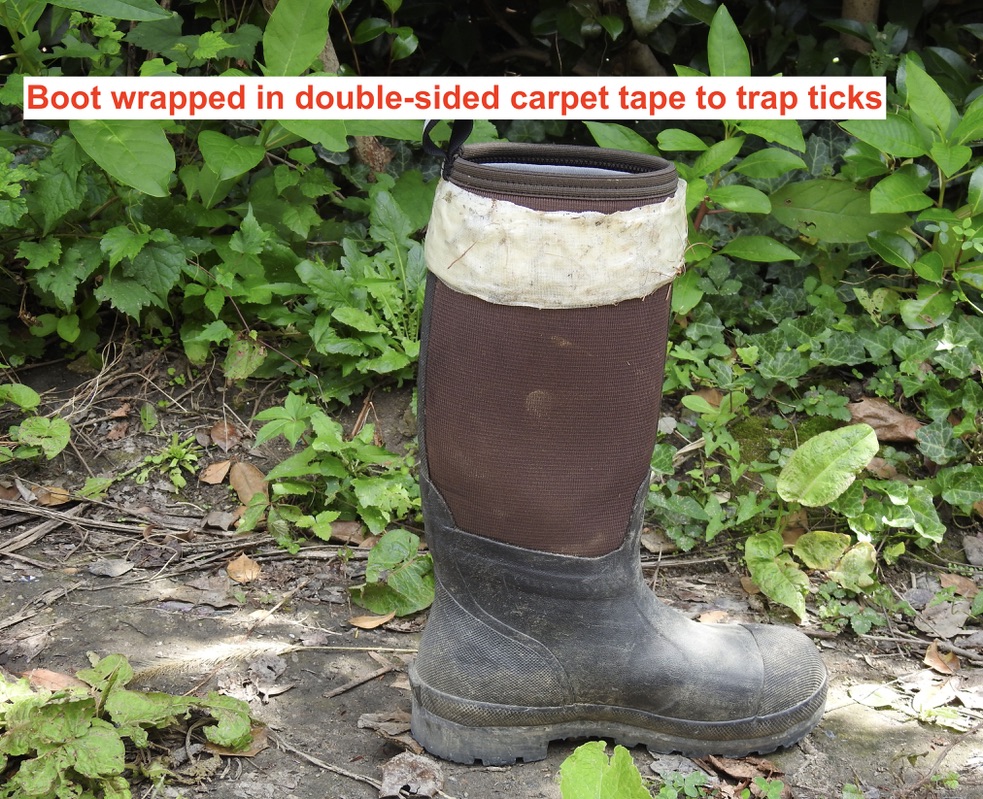
Wrap the tops of your boots with double-sided carpet tape
- Tick crawl up. The tape will trap ticks trying to crawl up your legs.
- I use two types of double-sided carpet tape:
- If you don’t wear boots, you can wrap your pants with tape, but do so at different heights so your legs don’t stick together.
Source: 18, personal experience

Permethrin
For shoes, clothing, and gear
Permethrin–don’t skip this step!
- The best way to avoid tick bites is to wear permethrin-treated shoes, socks, pants, shirts and gear.
- Permethrin kills ticks.
- You can buy permethrin-treated clothes, treat them yourself, or get them treated commercially by Insect Shield.
- Commercial permethrin treatment is more effective than spraying your clothes with permethrin at home.
- Do not apply permethrin to your skin or underclothing.
- Always read the label of permethrin products and follow the instructions carefully.
Tick-repellent Clothing Option #1:
Buy permethrin-treated clothing and gear
Professionally treatment last longer than home treatments, but keep in mind that the permethrin does wash out eventually. A popular brand is Insect Shield (see right). These companies also sell treated clothes:


Tick-repellent Clothing Option #2:
Have your own clothes treated
Use a service that treats your clothing with permethrin, like Insect Shield.
Tick-repellent Clothing Option #3:
Treat Your Clothes and Gear with Permethrin Yourself
Treat boots, clothes, and camping gear with products containing 0.5% permethrin (7). Sawyer Premium Insect Repellent is a popular choice.
- You should not apply permethrin to your skin or underclothes.
- Be sure to follow the instructions provided when applying permethrin.
- Permethrin can be toxic to some pets, such as cats, while wet.
- Don’t use permethrin spray around cats.
- Don’t let cats come into contact with permethrin-treated clothes until they are dry.
- If you own a cat, talk to your veterinarian before applying permethrin.

Source: CDC
Learn more about permethrin
Learn about permethrin and permethrin treated clothes from TERC.
Repellents
Repellents can be applied to your skin
Repellents
Repellents such as DEET can help protect you from tick bites, but do not rely exclusively on repellents:
- Permethrin kills ticks, but repellents only repel ticks.
- Repellents are not always effective against lone star ticks.
- Repellents like DEET are not sufficient to protect against tick bites.
- DEET is relatively short acting.
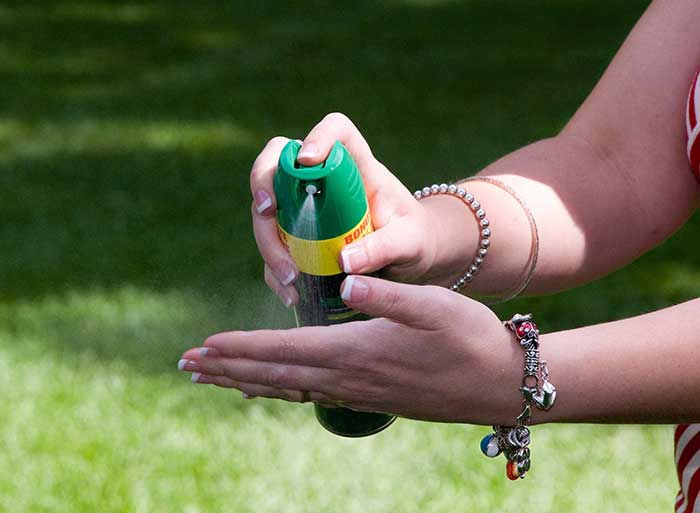
Source: CDC
Use Repellents on Your Body and Clothes
- Use EPA-registered insect repellents, such as DEET, picaridin, IR3535, Oil of Lemon Eucalyptus (OLE), para-menthane-diol (PMD), or 2-undecanone
- More information about these repellents can be found on the EPA site.
- Some repellents can be used on your body, some on your clothes, and some on both.
- Do not use insect repellent on babies younger than 2 months old.
- Do not use products containing OLE or PMD on children under 3 years old.
- This EPA tool can help you find the right repellent for you.
DEET Guidelines
- Higher concentrations of DEET offer longer protection. For example, 30% DEET will protect the user for an estimated 6 h, whereas 5% DEET offers 2 h of protection.
- Do NOT use DEET on children 2 months old or younger.
- Use DEET concentrations of 10% or less on children less than 12 years old.
- DEET can corrode some synthetic fabrics, like Gore-tex™.
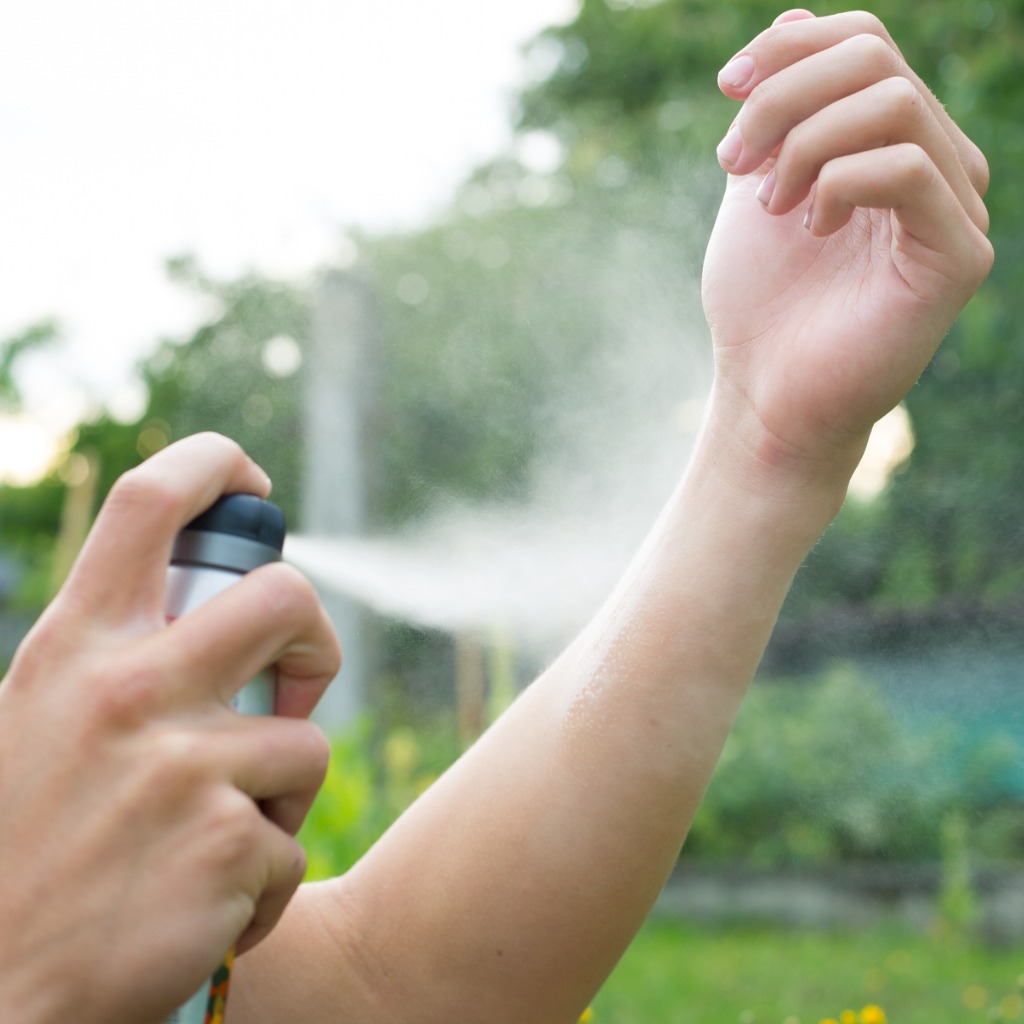
For more information about which repellents are effective against ticks read The Most Effective Tick Repellents for Humans (and Dogs), According to Science
While Out and About
Precautions to take while you are outdoors
Watch Where You Walk and Sit
- Avoid wooded and brushy areas with high grass and leaf litter (7).
- Walk in the center of trails (7).
- Keep moving. If you stay still for too long, Lone Star Ticks will detect your odor and come find you.
- Don’t linger in one spot for too long.
- Don’t sit in tick-infested areas.
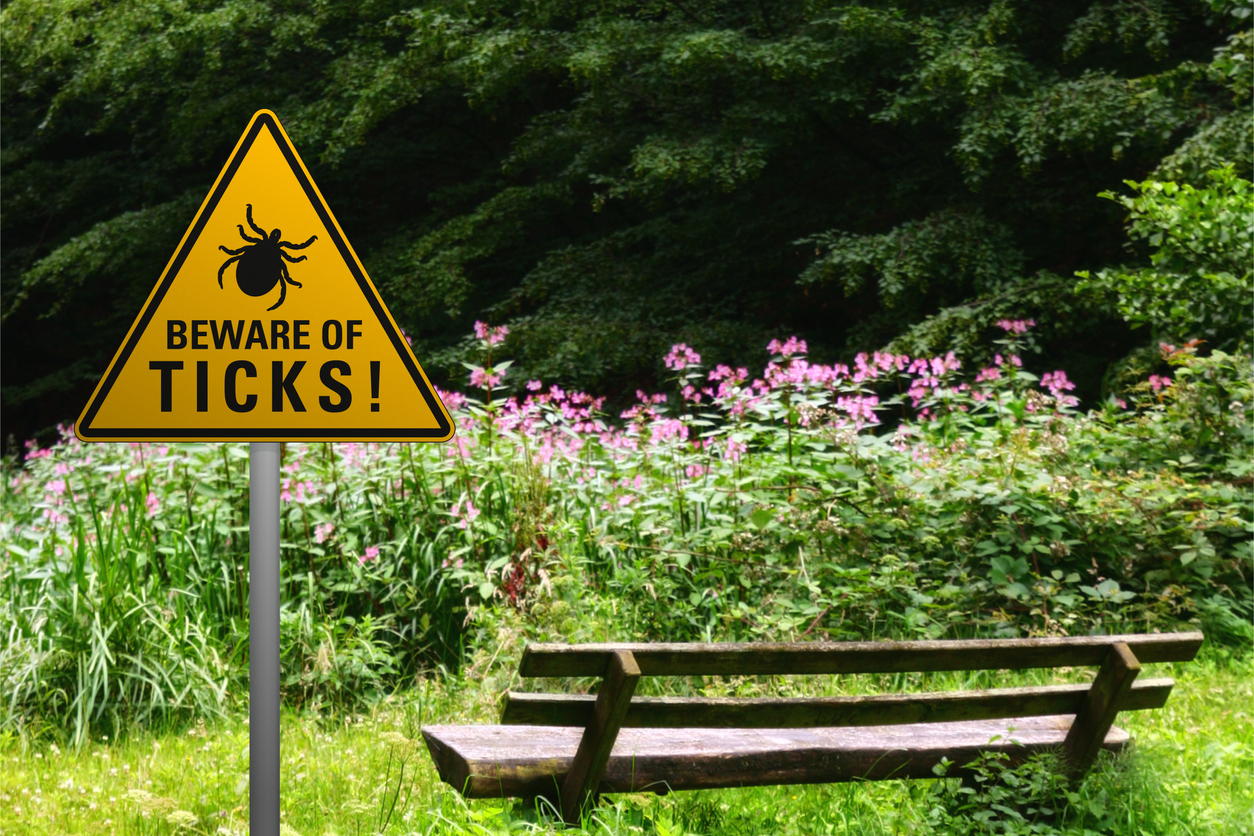

Check for Ticks Frequently
- While outdoors, check yourself and your children for ticks frequently.
Use a Lint Roller
- From time to time while out and about, to pick up small ticks that you don’t see
- To roll up larval tick bombs
- At the end of your outdoor activity, before you get in your car or enter your house.
- This is especially helpful in the spring and fall, when tiny tick nymphs and larvae are most abundant.
Source: 18, personal experience, expert advice (personal communication)
When You Get Home
When You Get Home
- Check your clothes, pets, and gear for ticks (7).
- Get a shower as soon as possible to wash off unattached ticks (7).
- Do a full-body tick check (7).
- Keep a handheld mirror in the shower to check in hard to see parts of your body.
- Remove any ticks you find immediately (7).
- Tumble your clothes in a clothes dryer on high for at least one hour before washing them to kill Lone Star Ticks. Washing clothes alone is not an effective way to kill lone star ticks (14). Heat and desiccation (drying out) kills ticks, not water.
- See What to Do If You Are Bitten by a Tick for more information about proper tick removal and what to do next.
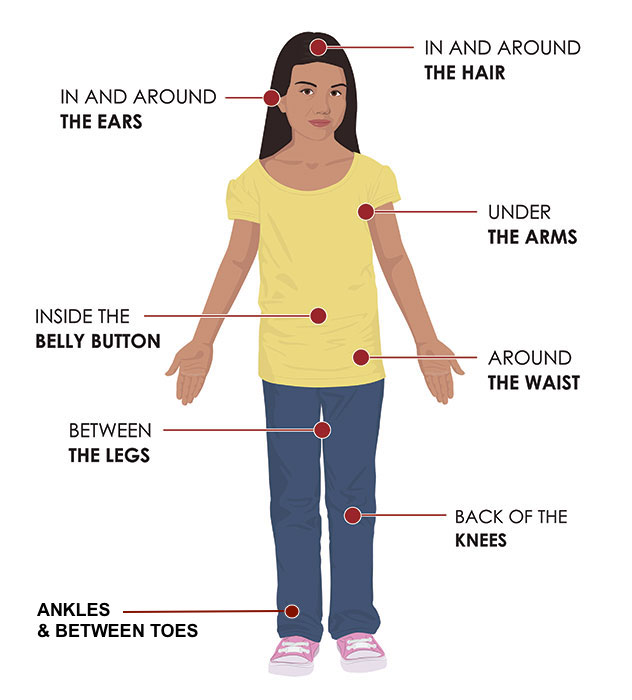
Source: CDC Tick Removal, modified to include ankles and toes based on recommendation of tick experts.
Avoiding Tick Bites
Downloadable brochure–print and share!
More Tick Tips From Holly
from Holly Tuten, the Vector Collector
More Information
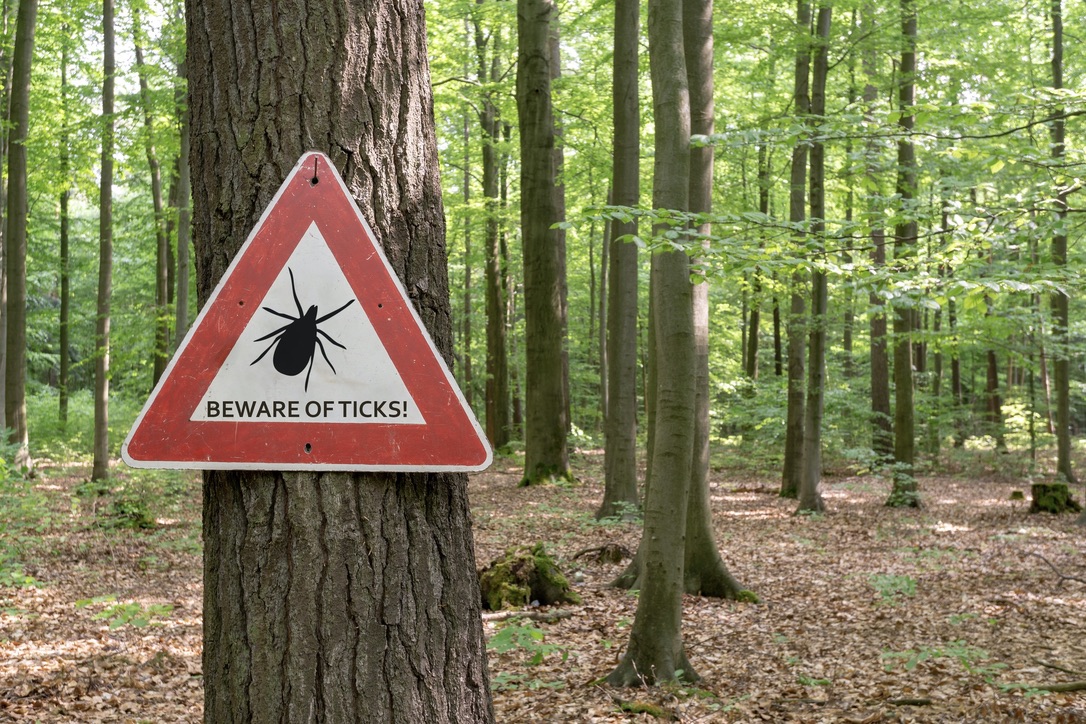
Ticks and Alpha-gal Syndrome→

What to Do If You Are Bitten by a Tick→

Ticks and Pets→
For more detailed information about ticks and how to cope with them go to the following websites:
CDC
TickEncounter
TIC NC
References
1. Hashizume H, Fujiyama T, Umayahara T, Kageyama R, Walls AF, Satoh T. Repeated Amblyomma testudinarium tick bites are associated with increased galactose-α-1, 3-galactose carbohydrate IgE antibody levels: a retrospective cohort study in a single institution. Journal of the American Academy of Dermatology. 2018 Jun 1;78(6):1135-41.
2. Commins SP. Diagnosis & management of Alpha-gal Syndrome: Lessons from 2,500 patients. Expert Review of Clinical Immunology. 2020 Jun 25. Forthcoming.
3. Kim MS, Straesser MD, Keshavarz B, Workman L, McGowan EC, Platts-Mills TA, Wilson JM. IgE to galactose-α-1, 3-galactose wanes over time in patients who avoid tick bites. The Journal of Allergy and Clinical Immunology: In Practice. 2020 Jan 1;8(1):364-7.
4. Paddock CD, Yabsley MJ. Ecological havoc, the rise of white-tailed deer, and the emergence of Amblyomma americanum-associated zoonoses in the United States. InWildlife and emerging zoonotic diseases: the biology, circumstances and consequences of cross-species transmission 2007 (pp. 289-324). Springer, Berlin, Heidelberg.
5. Lone Star Ticks in New Jersey: Risk, Ecology, and Prevention. Rutgers New Jersey Agricultural Experiment Station.
6. Molaei, G. et al. “Bracing for the Worst — Range Expansion of the Lone Star Tick in the Northeastern United States.” (2019). N Engl J Med; 381:2189-2192
7. CDC Ticks
8. Monzón, J. D., et al. (2016). “Population and Evolutionary Genomics of Amblyomma americanum, an Expanding Arthropod Disease Vector.” Genome Biology and Evolution 8(5): 1351-1360.
9. University of Rhode Island Tick Encounter Resource Center
10. “lone star tick – Amblyomma americanum (Linnaeus)”. entnemdept.ufl.edu.
11. Tick-Borne Infections of North Carolina, Inc.
12. Sonenshine DE. Range expansion of tick disease vectors in North America: implications for spread of tick-borne disease. International journal of environmental research and public health. 2018 Mar;15(3):478.
13. Woodson MM. Retrieved from: The low-down on ticks. Part 1A, Biology Q&A. NY State IPM Progeam. Cornell University. 2018 June.
14. Carroll JF. A cautionary note: survival of nymphs of two species of ticks (Acari: Ixodidae) among clothes laundered in an automatic washer. Journal of medical entomology. 2003 Sep 1;40(5):732-6.
15. Platts-Mills TA, Commins SP, Biedermann T, van Hage M, Levin M, Beck LA, Diuk-Wasser M, Jappe U, Apostolovic D, Minnicozzi M, Plaut M. On the cause and consequences of IgE to galactose-α-1, 3-galactose: a Report from the National Institute of Allergy and Infectious Disease Workshop on Understanding IgE-Mediated Mammalian Meat Allergy. Journal of Allergy and Clinical Immunology. 2020 Feb 10.
16. Ho BM, Davis HE, Forrester JD, Sheele JM, Haston T, Sanders L, Lee MC, Lareau S, Caudell M, Davis CB. Wilderness Medical Society Clinical Practice Guidelines for the Prevention and Management of Tick-Borne Illness in the United States. Wilderness & Environmental Medicine. 2021 Oct 9.
17. Merten HA, Durden LA. A state-by-state survey of ticks recorded from humans in the United States. J Vector Ecol. 2000;25(1):102-113.
18. Tick expert Holly Tuten, personal communication.
19. Lea Hamner; Tickborne Diseases with the MV Tick Program (Recorded presentation); Vineyard Haven Public Library; retrieved Jan 22, 2025.
All the information on alphagalinformation.org is provided in good faith, but we, the creators and authors of the Alpha-gal Information website offer no representation or warranty, explicit or implied, of the accuracy, adequacy, validity, reliability, availability, or completeness of any information on this site. Under no circumstances should we have any liability for any loss or damage incurred by you as a result of relying on information provided here. We are not physicians or medical professionals, researchers, or experts of any kind. Information provided in this website may contain errors and should be confirmed by a physician. Information provided here is not medical advice. It should not be relied upon for decisions about diagnosis, treatment, diet, food choice, nutrition, or any other health or medical decisions. For advice about health or medical decisions including, but not limited to, diagnosis, treatment, diet, and health care consult a physician.
READ FULL DISCLAIMER>


